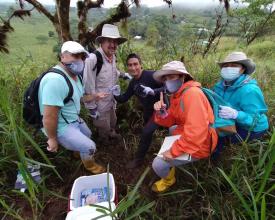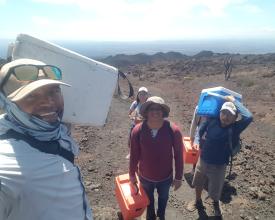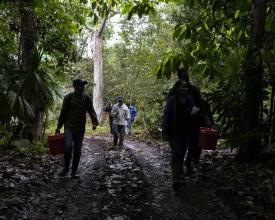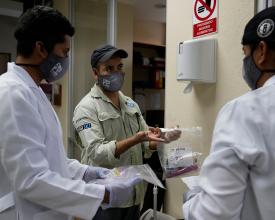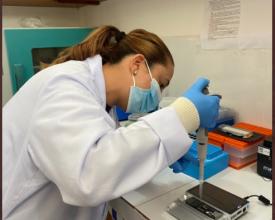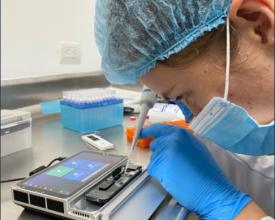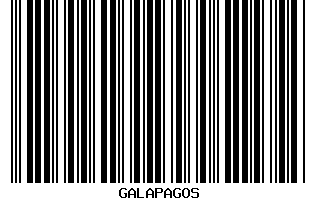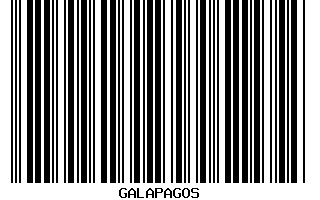
Barcoding Galapagos: Recording and mitigating Covid-19 impacts using key-workers in eco-tourism
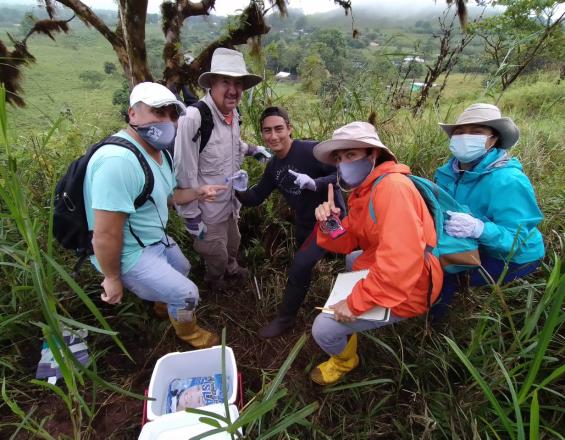
The Covid-19 pandemic has impacted the tourism industry in the Galapagos, putting thousands out of a job and threatening conservation efforts based on tourism income. In particular, naturalists guides, fishermen, and farmers were hit the hardest affecting the core of the island economy. This lack of income could also be detrimental to sensitive ecosystems by lifting adequate control and increasing fishing quotas as measures to mitigate this economic collapse. The Galapagos Barcode project's main goal is to directly employ naturalist guides (women and men equally) currently without income, to catalog the biodiversity of the Galapagos using DNA sequencing technology. By providing infrastructure and scientific training (cash for training), it will build local capacity and resilience, with implications for wildlife and ecosystem conservation, and socio-economic growth.
Context
Challenges addressed
Galapagos is a Natural World Heritage site (est.1976) and UNESCO Biosphere Reserve (est.1984) that inspires pioneering models of sustainability, conservation, and eco-tourism. Such models are celebrated for their long-term solutions to existing tensions between the preservation of biodiversity and the social-economic well-being of local inhabitants.
However, the Covid-19 pandemic has revealed their vulnerability to short-term perturbation. The consequence of this vulnerability is obviously far-reaching for a community wherein 80% are reliant on tourism. Here, we identify two interconnected and tangible issues that require urgent attention. First, the biodiversity from which we have learned so much and upon which the Galapagos’ relies for its eco-tourism industry, is
under imminent threat from harvesting. Second, naturalist guides, who are the 'eyes' of the park and disseminate Darwin’s legacy to the 275,000 tourists annually, have lost their income.
Beneficiaries
Direct: 74 local naturalist guides (employment), farmers, and fishermen (gender equity framework)
Indirect: Local agencies of control (invasive species and illegal trade)
Broad: Ecosystem and social beneficiaries
Location
Process
Summary of the process
Transfer of technology is the ability of the locals to learn and grasp the idea of novel information in use to a common goal. By creating capacity building locals are now exploring alternative jobs aside from the tourism industry. These new technology jobs could be important to diversify the pool of applications and a saturated tourist market, as well as to be resilient if the tourism industry collapses again.
The way they interact is through implementing such technologies to obtain quantifiable outcomes for diverse objectives (conservation, monitoring). Broad local participation is now done making use of these techniques which were restricted to scientists.
https://www.dw.com/es/econom%C3%ADa-creativa-juntos-por-gal%C3%A1pagos-los-j%C3%B3venes-defienden-su-tesoro-natural/av-59145042?maca=es-Whatsapp-sharing
Building Blocks
Transfer of Technology
-Use non-invasive 21st century genetic barcoding techniques to catalog the biodiversity of the main Galapagos Islands and surrounding marine reserve, from microbial to mammal;
-Train locals in key field, lab and curatorial techniques, and employ them to undertake the project, which can also open new job opportunities in the future
Enabling factors
Group of society in need of support (capacity building)
Group of society that understands the power of science and technology
Individuals that are eager and excited to participate
Economic collapse due to banned of tourism to a community that depends on visitors
Good perception of science and scientists in the society
Lesson learned
Lots of interest from the community to get involved with more than 300 applications.
Resilience from the local population by finding new areas of employment (STEM) as citizen-scientists, lab technicians, field biologists. This shows an interest from the public to learn the need for diversifying job opportunities and technical tools to be developed (demystifying science and accessibility).
Excitement by the use of cutting-edge equipment, hands-on experiences enhanced by involvement in most modern sequencing techniques available.
Challenges in translating scientific terms to non-scientists, and bridging the gap between scientific knowledge and applicability by locals.
Lots of good testimonies suggest we recognized a gender issue (employment).
Clear measurable outcomes
Quantifiable outcomes for the participants. We trained 74 locals (naturalist guides, farmers, and fishermen) in research skills, field experience, laboratory (molecular work), and sequencing (DNA) tools.
The number of species sampled. To date, we have produced over 10,000 of DNA sequences from soil and water samples to be analyzed, all produced on the Galapagos by local trainees.
Field trips and samples collected: In total, 15 field seasons were performed on three islands where locals learn field techniques and data collection. We have already collected over 200 samples of soil (microbiome research) and 10 of water (metabarcoding).
Enabling factors
Physical space to deploy the technology
Molecular equipment and reagents shipped to the Galapagos (via local collaborators Universidad San Francisco de Quito)
Community acceptance and support. Local agencies (Agencia de Biocontrol y Seguridad) partnership allowed the training of locals on 2 islands synchronously,
Lesson learned
Hiring 74 locals for a period of 10 months is an expensive endeavor, but gratifying to know we helped 74 families with income during the pandemic
These past months of work have represented a full-time job for several team leaders managing the grant, finances, and purchasing.
Local trainees have shared via our impact team recordings (survey) and high reward and gratification. The measurable metric of well-being shows high values for all participants and increases trust and acceptance of institutions and people behind this project in the community.
Long-lasting effects: Most trainees will return to participate in a similar project if given the opportunity. We are currently assessing the number of participants' economic well-being and engagement in STEM employment.
Resources
Impacts
This non-invasive technology is used to catalog the islands’ genetic diversity at the ecosystem level; to identify illegal capture and trafficking of endangered species, and to identify and interfere with invasive species that arrive on ships or by air. The employment of naturalist guides who have lost their livelihoods due to the pandemic are now knowledgeable on barcode techniques, generating new job opportunities in research and technology, thus creating resilience for future uncertain times
Sustainable Development Goals
Story
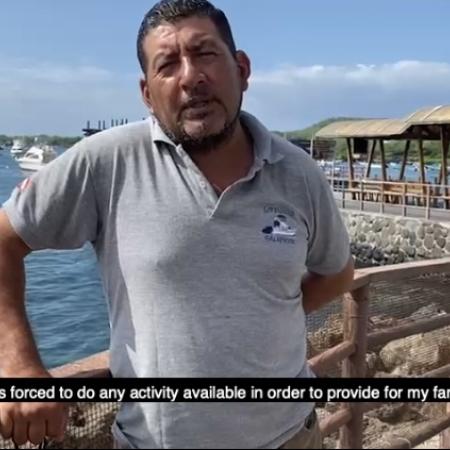
>Hello, I´m Karen Asencio and I´m a naturalist guide of the Galapagos National Park. The project is very important as it has included the local population in the scientific world. Involving the community with the national parks is crucial for conservation, especially in the Galapagos Islands. Being part of this project has been a very positive experience from which I´ve gained a lot, like the conferences and new knowledge on a daily basis. I haven´t had any negative experiences with this, but, if any appear, we will take it as a challenge to learn and grow professionally.
> Hi, I´m Joel Mariño and I´m a naturalist guide at Isabela Island. This project has affected my life in a positive way. During the pandemic I lost my job because I work in tourism, a field that was severely hit in the Galapagos Islands. This project has provided a job and a source of income, as well as a great professional experience. In my opinion, it will be very useful for me in the future because, as a guide, I will be better equipped to interpret the Islands and give tourists a better experience”
>I´m Fernando Sánchez. Personally, I found most interest in the methodology to be used in the project, which uses cutting-edge technology with equipment that allows taking a lab to the field. This reduces the time for analysis and allows for very efficient sampling. We learned that the eDNA methodology brings new opportunities for Galapagos to identify invasive species, new species that have not been cataloged in the Islands. Thus, I believe this is a pioneering project that will lay the groundwork for future research in the Galapagos Islands”.
>I´m Michelle Heras, I work on the production and commercialization of handcrafts of Galapagos. I´m also a professional in the tourism industry. One of the best experiences in the project has been to know new people, exchange ideas and learnings, exchange childhood and adolescent experiences, professional experiences, economic reactivation, and we have always talked about the important economic support that this project has provided. Also, I have had the opportunity to work with other people working on production. In my case, with my family, we work on wood handcrafts, but others work on artisanal fishing, agriculture, cattle raising, other professions as biologists and biotechnologists. Having this opportunity of inclusiveness, exchange ideas and work with the same focus.
